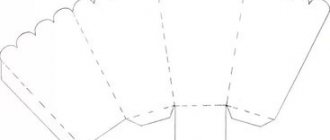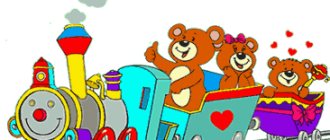Class on CT (design) for children of middle preschool age in the “Bus for Friends” group.
Target:
teach children to make an image of a bus from ready-made parts (windows, doors, wheels).
To develop their skills in folding a sheet of paper in half, aligning the sides and corners.
Strengthen the ability to glue paper parts (windows, doors, wheels) to a reference line.
Develop eye, clarity of hand movements, attention.
To instill accuracy in work in preschoolers.
Preliminary work: examination of the observation album “Buses”. Learning the song “Blue Bus”.
Materials for each child: bus body blank (sheet of cardboard with cut corners), 5 squares (windows), 2 strips (bus dividing strip), 2 short strips (doors), 2 triangles (front windows), 4 circles (wheels) , glue stick, napkins, cut out animal figures.
Contents of direct educational activities:
Children sit on modules. There's a knock on the door. The postman comes and brings a letter.
Educator: - Guys, we have a letter. Let's see who it's from. It was the inhabitants of the forest who sent us a letter. They really want to come to us for the Autumn holiday, but no transport goes to their forest. They ask us to help them get to our kindergarten. Shall we help?
-Guys, let's think about what types of transport you know? Children's answers: plane, helicopter, car, etc.
-Well done guys, you know many types of transport. But the animals wrote a clue in a letter to us:
What kind of miracle is the long house?
There are a lot of passengers in it
Wears rubber shoes
And it runs on gasoline.
(Bus) .
— That’s right, guys, this is a bus (the teacher takes a large paper bus out of the envelope). How can we help animals? I only have one bus, but there are many residents.
Children's answers: make more buses.
-What a great idea, let's make buses.
But first, let's look at the bus. What parts does the bus consist of? Children's answers: body, windows, doors, wheels. Where are they located?
Right. Now we will sit down at the tables. Each of you has blanks of bus parts. Let's look at them and try to put everything in its place. What will we make the body from (from a large sheet of cardboard). That's right, we need to bend it in half. So that the sides and corners touch each other.
-What shape will we make wheels from? (circles) how many are there? (4)
-Why do you think you have two long stripes? Right. To divide each side of the bus into two equal parts - in half.
-What are two short stripes for? (doors)
-What geometric shapes will you make windows from? (squares and triangles).
-What will serve as wheels for us? (circles). The wheels on both sides are at the same distance opposite each other. Pair.
Please note that on one side the bus has doors, but on the other there are no doors.
So we laid out the parts of the bus. Now let's secure it all with glue.
Educator: Guys, there are still images of animals in the envelope. Let's put every animal on the bus. Children stick pictures on bus windows.
-What a great fellow you are, you made wonderful buses. Let's play with them.
Game "Traffic lights and cars"
— Guys, you did a very useful thing today. You helped the animals get to the Autumn festival in our garden. Tell me, did you like designing buses? Well done.
The animals are very grateful to you and give you treats (juice) for this.
Author: Franchuk Tatyana Valentinovna
Progress of the lesson
Guys, today we will be automakers. Can I be your director? Designers from our automobile plant sent us drawings of the cars . You and I will have to build models of cars . Let's go to our office. Sit down at the tables and look at our drawings. (Teacher puts drawings on the board )
Look at the drawings of the cars and tell me what type of transport it is?
_Is this a freight transport?
_ Why did you decide so?
_ Because all cars have a body for transporting goods.
_How are these cars ?
_ All cars have common parts : cabin, headlights, body, wheels.
_How are they different?
_ The vehicle for transporting construction materials has a long body.
__ The vehicle for transporting furniture, televisions, refrigerators has a high and necessarily covered body.
_ a milk tanker or a fuel tanker has a tank.
That's right, guys the cars differ in their purpose.
Guys, look at these drawings and choose who will build what.
Maxim: “I will build a van and I want Zhenya to help me”
Oh, Nadya, you want to build? “I want to build a panel truck and I will build it with Yulia”
Sonya, what will you choose? “I like KamAZ and I want Dasha to help me”
What would you like to build, Vika? “I want to build a milk tanker, and Danil will be my assistant”
The teacher lays out the drawings on the children's tables.
Guys, look carefully at your drawings again. Please note: what parts does the machine shown in the drawing consist of? what parts the builder needs to select to complete the job; discuss where it is better to start building a car , which side to put the parts on, determine the stages of construction.
Now let's go to the workshop where we will make car models .
Children put diagrams on the board in the workshop.
Educator: In the workshop, building materials and drawings of your models of cars that you will build have been prepared for you.
MAGAZINE Preschooler.RF
Summary of a design lesson in a multi-age group “Truck”Goal: developing the ability to create an object from a TIKO constructor in accordance with the diagram.
Objectives: Educational: to develop the ability to correlate a real object with a diagram. Introduce the plan of analysis of both the subject itself and its schematic representation.
Educational: Cultivate accuracy in work, strive for results. Develop the ability to not interfere with your friend while building a car. Instill in children responsibility for their own safety; street culture.
Developmental. To develop in children the ability to read diagrams, to determine from the diagram what building parts the machine is built from. Develop skills in constructing statements and reasoning.
Methodical techniques:
- visual
- verbal
- practical
- problem-search
- encouragement
Material: handout: TIKO designer parts, diagrams.
Progress of the lesson.
1. Educator: Guys, look, we have guests today, let’s say hello to them.
Educator: who else came to visit us? slide 1
Children: Masha.
-Teacher: Guys, Grandma decided to move to a new house and asked Masha to help her, but Masha doesn’t know how to transport things and furniture.
- Shall we help Masha move her things?
-What do you guys think, what can you use to transport things and furniture?
(Truck)
- Look at the screen, which of these cars can you transport things on? slide 2
-Name the cars (car, concrete mixer, motorcycle, school bus)
- Guys, we don’t have a truck, what should we do? Children: (build).
— What can you build a truck from? (from constructor)
-Why is it called cargo? (Transports various cargoes)
Let's take a look at the truck! (children examine the structure of building parts, identify the main functional parts in it, determine their spatial position, size and shape). slide 3
— Tell me, guys, what is the name of the front part of the truck? (driver's cabin).
— Which part of the machine is the heavy load loaded into? (into the body)
-Which part of the truck was not named? (wheels)
— What kind of cargo do you think trucks can transport? (boards, logs, bricks, potatoes, etc.) In a word, everything that is heavier.
— Guys, I propose to make a truck from a TIKO construction set.
-I have a picture - a diagram according to which you can build exactly the same truck. slide 4
-What parts is the truck cabin made of? (3 squares and 1 triangle)
— What parts is the truck body made of? (Rectangle)
- And this geometric figure is new to you, it’s called a pentagon.
-Why do they call her that? (5 corners)
PHYSICAL MINUTE “Be careful”
We are driving, we are driving a car, they imitate the movements of the steering wheel.
We press the pedal. The leg is bent and extended.
We turn on the gas, turn it off, turn the imaginary lever with your hand towards you, away from you.
We look intently into the distance and put our palm to our forehead.
The wipers clean off the drops. Hands are bent at the elbows in front of you, palms
reveal.
Right left. Purity! Tilt your arms left and right.
The wind ruffles my hair. They move their fingers above their heads.
We are drivers anywhere! Raise your thumb up.
- Well done. Now go to the tables and build a truck according to this scheme. We begin to work according to the scheme, all the details are in front of you.
— I want to draw your attention to the fact that the cars can be multi-colored, but the geometric shapes must match the diagram.
(Children's independent work).
- Well done boys! How many beautiful trucks did you get: each one has its own, just like in the picture. You completed the task. Masha understood which car should be used to transport her grandmother’s things.
— Guys, look at the screen slide 5
Masha says: Thank you very much for your help and goodbye.
Educator: Guys, what did you do today? What did you like most?
(We built a truck according to the diagram)
-Do you like the cars you made?
- Guys, what are you in the mood? (cheerful, joyful, happy)
Educator: Well done, thank you.
| Next > |



